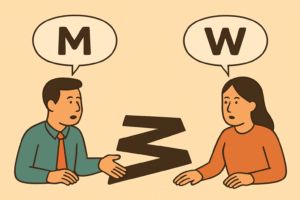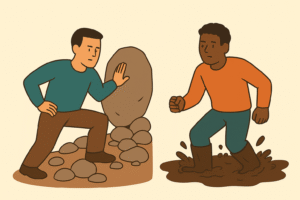Introducing organizational change is a tricky business, especially when it involves new technology. Even seemingly innocuous changes to technology can have a far-reaching impact on your organization, disrupting the ways you work. Your initial vision of a smooth implementation, rapid adoption, and a high return on investment is easy to say, but not so easy to achieve. For example, it is widely discussed that 70% of transformations fail.
The problem is not a technological one. There is no silver bullet that will untangle the mess that is your adoption of new technology, you also need to adopt new ways of working. The typical approach of applying a framework that worked elsewhere often fails. To create lasting change, we need to take a different approach and invite people to inflict change on them. In turn, finding a path to a way of working that fits your people and teams.
With that many buzzwords in a sentence, this must be an important topic! Of course, we have an approach to help achieve this. Below I break down this approach that we’ve used to help organizations:
- Get clarity on where to best invest your time
- De-risk their program roadmaps
- Determine how to realize the benefits from their technology investment
To achieve this, we focus on generating outcomes-focused roadmaps, creating visibility into how work is flowing, and identifying how to make continual improvement sustainable. What’s more, in the process we help the people in your organization create the passion and flow they need to sustain the transformation.
Interested?

Crystalizing Strategy
Let’s start at the beginning.
At the senior leader level, you understand there is a need for change. You are fully bought in. So how can you get the rest of the organization to see what you see?
The first step is switching from thinking of the technology implementation as a series of targets, and outputs of an installation process planned for months. By instead starting to think in terms of the outcomes you want you can better articulate your goals to your teams.
This won’t happen overnight but conducting Outcome Mapping exercises is an excellent place to begin. We access outcomes based on revenue, cost, and risk to build a strategy that helps prioritize the outcomes and highlight potential obstacles.
This practice will allow you to more clearly define your outcomes and develop your strategic roadmap. More importantly, the exercise itself will create alignment and deeper understanding within your team.
Outcome Mapping also allows us to capture high-level value flows through the organization. Even more importantly, with “value” being such a loaded word, we work on identifying what that means for you and the customers you are serving. This is important because it allows us to create a common understanding we can use for subsequent activities.
To wrap up the work, we take our new-found knowledge and map the desired outputs to the outcomes. It is not uncommon to find that the solutions to the business problem the outputs represent do not map to the outcomes the organization wants.
For example, the outputs might create a capability that will no longer help achieve the outcomes you are looking for. Sometimes these outputs are all tied to satisfying a traditional SDLC governance process and can provide valuable indicators that can become input to our next mapping exercise.
By shifting the focus to the desired outcomes while acknowledging the work done to date, we encourage a new system of work. A system that will enable the learning necessary to get the results they need in the timeline they’ve set. In this way, the activity of mapping is even more valuable than the map itself.
Now we have a foundation based on outcomes and have begun to create alignment. Through this alone, we’ve used to demonstrate and achieve significant benefits. For clients we are working with, this greater understanding allows them to identify where best to focus their efforts, often resulting in direct financial benefits.
Identifying where to start
Crystalizing your strategy alone will not get you there. We need to get more detail about the impact on different areas. We use the knowledge of the high-level streams gained in our Outcomes Mapping exercises to pick which areas to focus on first and map in more detail.
Using a lightweight Value Stream Mapping exercise, we begin to make work visible. This is important because work moves through our organization in the same way as the flow of value through a system (which is what VSM identifies for us).
That system is made up of the many parts of the organization that contribute to the delivery of that value to your customers and by mapping them we identify opportunities for improvement. To simplify this concept we call it Value Delivery.
Once again, the process of mapping is more important than the map itself. By collaboratively generating the map we create alignment into how work occurs and where we need to introduce change first. This lays the groundwork for the initial wins that will fuel the messaging and aid further adoption.
To further identify what else will impact the value delivery process, we conduct Dependency Mapping exercises. These play an important role in ensuring we have not missed any governance needs the organization may have and take them into account.
Lastly, we need to determine the feasibility of the changes we are proposing and perhaps identify any gaps. We do this by conducting a Capability Map to look at the skills and systems in place.
With this information in hand, we create a map of the possible future state. With this, we create what we describe as the Minimum Viable Bureaucracy, just enough governance to meet your organizational needs and the procedures to manage it. In highly regulated environments we’ve worked in, such as banks and healthcare, this is a critical area of concern.
Make it sustainable
Traditional methods of rolling out changes often falter, especially when involving multiple lines of business and complex organizational challenges. To overcome this, we help build out a team that will facilitate the transformation of the organization’s ways of working.
We call this the Value Delivery Team. They take a role in identifying champions and influencers, empowering them with the skills they need, and messaging the change to the organization. Having this team smooths the technology adoption by having them as consultants and coaches to teams looking to work out how to change their ways of working.
To drive sustainable improvement, behavioral change needs to be built on understanding, choice, and a sense of ownership. This is where your Value Delivery Team helps by being an enabling force for helping the organization identify and adopt their new ways of working.
Furthermore, for the change to stick and for us not to fall back into old habits, we need to continually reinforce and support the new ways of working. By repeating the mapping exercises we can build feedback loops that enable us to continually improve.
The value delivery team cannot do this alone, we need others to propagate and grow the change. We employ several methods to do this, depending on the nature of the change and the area we need to impact. The most common ones we have found work best are:
Accelerator programs – These work well when we want to bolster up champions with in-depth expertise. Especially when the new way of working involves complex changes to systems. They need to be run in conjunction with other methods to avoid the “sole expert” becoming a disrupting influence.
Communities of Practice – Practice, not excellence. Excellence puts the group on a pillar, practice means we are collaboratively sourcing new ways of working to feed continual improvement.
Dojo – Being able to come and practice and learn in an environment away from the day-to-day rigor is a powerful way to help learn. Teams can bring complex problems and safely experiment and learn how to apply the new tools and ways of working to them.
Conclusion
So there you have it. A method that may make your transformation many times more effective by generating outcomes-focused roadmaps, creating visibility into how work is flowing, and identifying how to make continual improvement sustainable. It takes work, but we’ve seen incredible results from taking this approach.
For example, we took one organization from a time-to-market for a new product release from 6-9 months to 6-9 weeks while demonstrating an 8% increase in team happiness scores. The benefits over time have been profound, resulting in saving them millions in development dollars and a measurable reduction in staff turnover.
By taking a foundational approach to change, we meet organizations where they are today, showing them how to achieve their transformation sustainably.
Have questions? Want to achieve outcomes like these yourself?
If you’d like to discuss achieving outcomes like these, you can book my calendar.
These can be powerful conversations to get you started and help get you unstuck.




